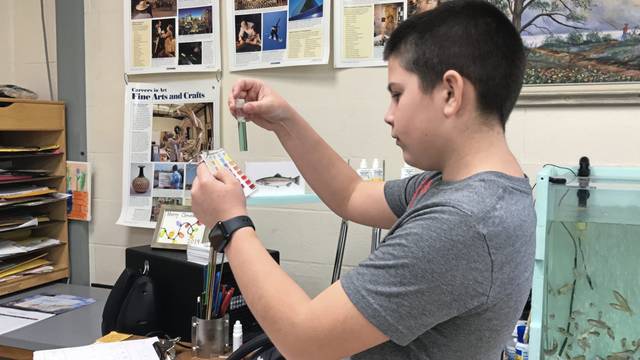Trout in the Classroom program going swimmingly in Hempfield
Proudly displayed fish artwork isn’t all that students at West Hempfield Elementary School have to show off.
First through fifth graders are raising almost 200 rainbow trout through the Pennsylvania Trout in the Classroom program. The local curriculum was implemented by art teacher Matt Clark as a way to incorporate STEM — science, technology, engineering and math — activities into the school.
“I never experienced anything like this in elementary school,” Clark said. “I think it’s important for them to realize that it’s not something separate from art or art isn’t something separate. It’s all interconnected somehow. … If anything, it sparks an interest with these kids to help them pursue their dreams going down the road. That’s awesome.”
Originally receiving about 350 trout eggs in October, students have been tasked with feeding them and testing the water to ensure the trout can be released into the Loyalhanna Creek with the help of a local Trout Unlimited chapter.
Prior to receiving the eggs, Clark said he bought a 50-gallon tank, filter and chiller to keep the water at 52 degrees. Help for the purchases came from a FirstEnergy Classroom STEM grant and the Hempfield Area Foundation Funds.
Overall, the project cost around $1,600 to implement and could cost an additional $250 for filter maintenance, replacing chemicals and tests.
Trout in the Classroom
Several area schools have taken advantage of the Trout in the Classroom program, including 27 Allegheny County schools and 12 in Westmoreland. In all, over 400 classrooms across the state follow the program, which is run by the Pennsylvania Fish and Boat Commission.
“It is a way to connect students to our natural world and cold water ecosystems no matter where they live,” said Rachel Kester, program director of Pennsylvania Trout Unlimited. “Raising the trout from eggs gives the students a chance to learn about the life-cycle of trout, how they are an indicator of good water quality, and what we need to do to ensure that our local waterways remain healthy and able to support aquatic life.”
Larry Myers, president of the Forbes Trail Trout Unlimited chapter, said the goal of the program is to teach students about the fragile environment trout are raised in, which is threatened by climate change, floods and development.
“As the kids get older and they become voters, then they’ll have a say in some of these laws that will protect our cold water fisheries,” Myers said.
This year, the program was changed for students to raise rainbow trout instead of brook trout — the state’s official fish — due to an infestation of gill lice. The parasite attaches to the gills of trout. There is one species specific to brook trout, another to rainbows.
For Hempfield students, the change in fish also meant a change in where they can release the trout, which is typically at Linn Run State Park.
Now, the rainbow trout will be released at the Loyalhanna Nature Trail in Ligonier to avoid disrupting the native brook trout at Linn Run.
Students will release the fish in April. Afterward, they will go to Powdermill Nature Reserve in Cook Township. There they will conduct stream studies to identify natural food the fish will eat and create silkscreens with a representative from the Andy Warhol Museum in Pittsburgh.
Growing interests
The eggs arrived in October, and about 50 already were dead, Clark said. That left students with around 300 trout to raise. As the fish grew, Clark realized he had more than needed, so about 60 were donated to the Valley School of Ligonier to help with their program.
If the program continues to do well at Hempfield, another 60 will be donated to Intermediate Unit 1 in Washington County.
“The amount, the health, the size is I think a little extraordinary,” Clark said of the Hempfield program’s success, adding that the trout are about two and a half inches long.
Over four months, students have taken an interest in the project and are learning different aspects of stream habitats, adaptation and social changes in their science and social studies classes.
Anthony Petrini, a fifth grader, said he helps test the tank water’s acidity.
After the program started, first grader Levon Hall checked out a library book about trout so he could learn more.
His favorite thing is to feed the fish, “Because I never fed the fish before.”
Our trout are enjoying some sunshine today!@fishandboat @PennsylvaniaTU pic.twitter.com/ygf0EvTWB6
— HASD W Hempfield Ele (@hasd_whe) January 21, 2020
For each student, there is a different attraction to the project.
“I like coming to class each time and looking at the fish and how much they’ve grown,” said fifth grader Harlyn Ramirez.
Remove the ads from your TribLIVE reading experience but still support the journalists who create the content with TribLIVE Ad-Free.



